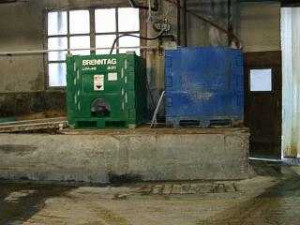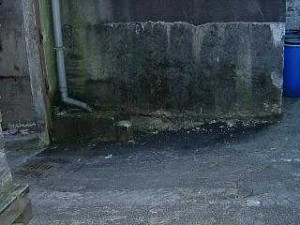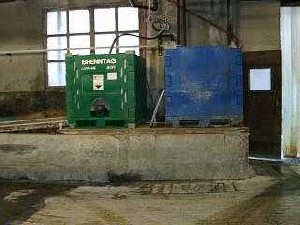A leak occurred on the lower drainage pipe of a 16-m³ tank containing 10.3 m³ of sulphuric acid. The tank operating under 2 bar of pressure was feeding a tanning workshop. Further downstream, plant effluent was neutralised using lime milk and then treated with ferrous sulphate (i.e. sulphide precipitate); this effluent emptied into the site’s settling basin before reaching a collective biological treatment plant. At 5 am, workers observed the presence of product in the retention basin. At 6:15 am, the head of maintenance, in recognising the inability to bring the leak under control, notified the plant director and turned off the tank pressure surge. Leaving open the retention drainage system caused the massive intake of a highly acidic effluent in the municipal stormwater treatment plant at 7:30 am. The settling basin pump was then shut down and the drainage device closed. The operator proceeded by pouring the acid still present in the tank into 3,000-litre containers. Around 8 am, cracks on the retention basin filled with 7,300 litres of product began to cause leaks. Some 500 litres polluted the COUARD stream, which crosses the site, over a 400-m section and then reached the MOSELLE River over a 500-m stretch, resulting in the death of a large fish population. A fish farm was also contaminated by the leak. The operator channelled 6,000 litres of acid into the settling pond (since operations were being threatened at the municipal treatment plant) and then notified the fire station, town hall and 15 minutes later the local Prefect’s office. In conjunction with this step, the operator neutralised the 800 litres of acid still present inside the basin by introducing sodium carbonate (soda ash). Upon arriving at the scene, the fire-fighting crew installed a sand dyke upstream of the watercourse. Around 2:30 pm, a specialised firm was called to the site to pump basin contents, which were then rinsed with water. Three hours later, an emergency prefectural order prohibited the operator from discharging any hazardous substances into the biological treatment plant intake. Backed by a specialist subcontractor, the operator on May 29th introduced a pH neutralisation and control system for settling pond effluents prior to treatment plant discharge. This modification helped bring the situation at the site back to normal as of June 2nd. Several anomalies were observed as regards the Prefect’s ordinances: a cracked retention basin, failure to complete periodic inspections, and a noncompliant lower drainage pipe. This pipe had consistently been carrying a load and could not be sealed by installing an internal plug. The operator kept the basin offline, given its oversized dimensions relative to the unit’s needs, preferring instead to use two 1,000-liter containers on a retention set-up in the tanning shop.
Download the detailed report in .pdf format (165 Kb)






